Nordic Food Lab: In Pursuit of Deliciousness
What do bugs, fermented dried yellow peas and popcorn have in common? They’re all in the kitchen of the Nordic Food Lab, of course! The small kitchen turned science lab (or is that backwards?) is located in Copenhagen and is a not-for-profit, self-governed organization founded in 2008 by Noma´s Chef-owner Rene Redzepi and food entrepreneur Claus Meyer with one primary goal: finding diverse, local, sustainable sources of deliciousness.
Ben Reade, current Head of Culinary Research of Development, and his team at the Nordic Food Lab have been experimenting with up to 30 local flavors a day just to find 1 or 2 among them that makes the cut to the next round of the creative process.
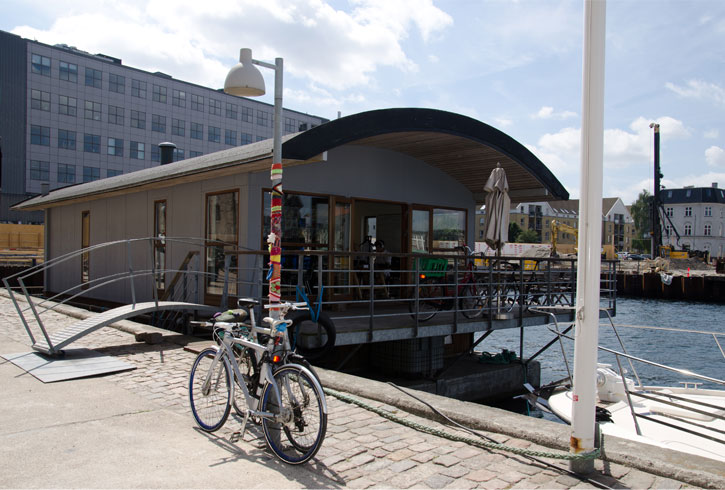
The key, says Reade, is that “there can be no inhibitions of the creative faculties and no fear of failing…In fact, in creating new foods, genuinely innovative foods, you have to expect failure.” That’s how you ultimately succeed.
Let's take a peek inside the fascinating Nordic Food Lab. You'll find some delicious bee larvae ceviche, mummified deer leg and an aging quince balsamic vinegar that will be ready in 2025!
The Future of Food Floating on a Copenhagen Dock
In our last trip to Copenhagen we had the chance to visit one of the most exciting food labs in the world. It’s located on a humble-looking boat just a few meters away from the restaurant Noma in the diverse neighborhood of Christianshaven.
Using modern and traditional methods they combine science and craft, and dig deep into new food experiments to achieve new flavors. As the name indicates, the Nordic Food Lab focuses its work on Nordic materials and food culture, but their work is not constrained by the geography. Reade explains that, “yes, there is an aspect on trying to be as Nordic as possible, but with an open mind. It’s really important to acknowledge that culinary cultures are fluid, they are evolving. It’s all about cultural exchange”.
This freedom is noticeable as soon as you start looking at what they are working on: lots of local roots and herbs, fermented and salted fish, but also experiments using Chinese Pu-er tea and preserved deer meat inspired by the Japanese Katsuobushi.
Inside the boat is where all of the good stuff happens. It’s part professional kitchen and part research lab. There are glass jars full of local woods and roots, a coffee bean Koji experiment, deer legs coated with a variety of concoctions similar to mummification procedures, and a wide variety of oils, vinegars and various other foodstuffs in various stages of mold or fermentation. One of the stars of the show, though, is the Quince Balsamic vinegar resting in different types of wooden barrels. They’ll be ready in 2025.
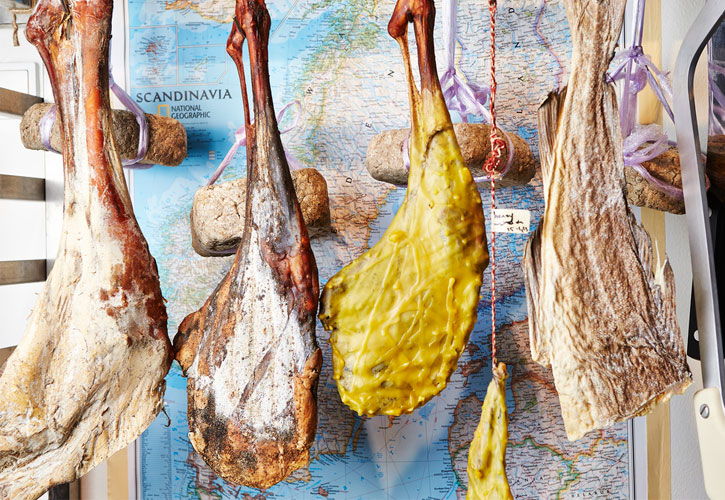
In this picture we can see a selection of cured meat experiments. The deer legs were treated with a technique inspired by mummification. The 3rd one from left to right was brushed with local honey and coated with bees wax.
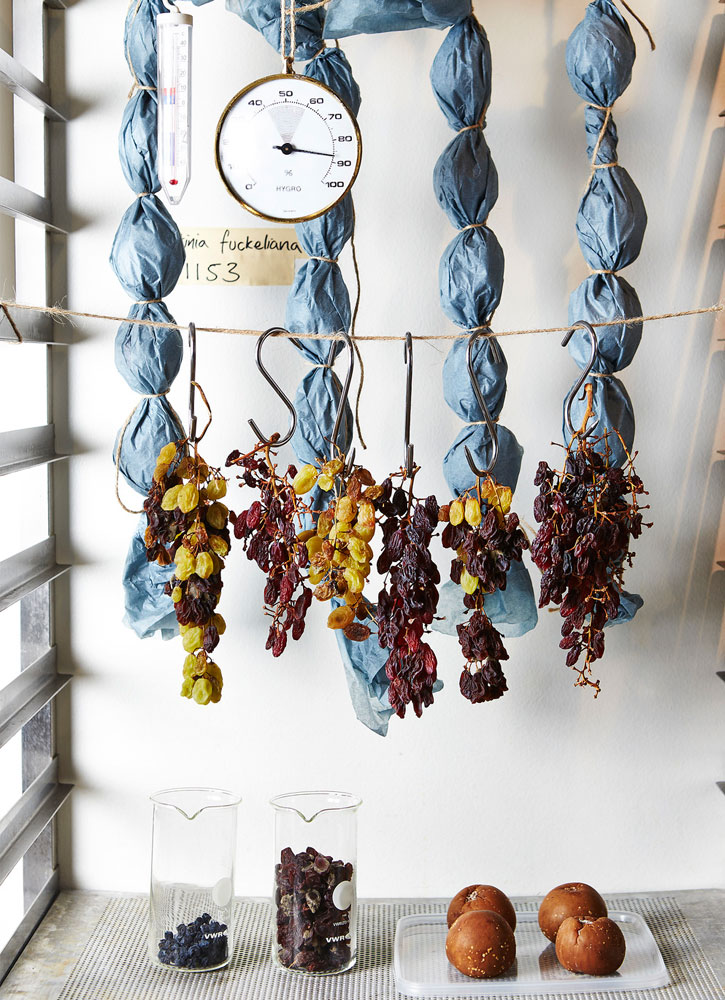
These grapes are suffering the effects of Botriyotinia Fuckeliana (also known as Botrytis Cinerea). It is the mold which is the causal agent of the grey mold disease.
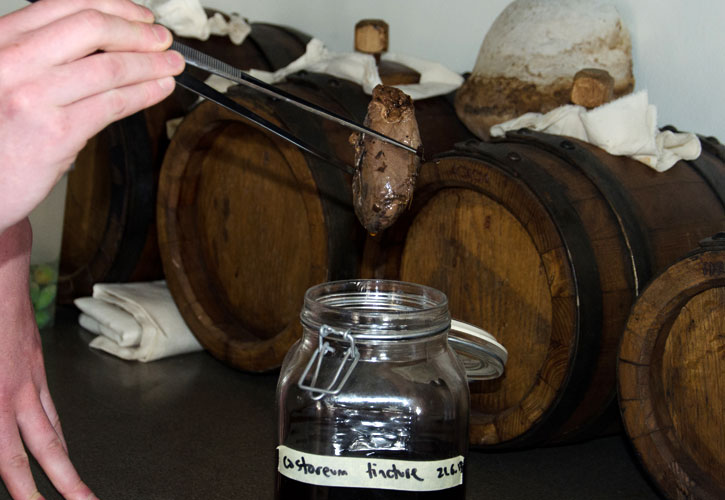
Castoreum Tincture, made with the exudate from a gland located in the back of a Beaver (in this case from Sweden). It is normally used in perfumery, as a powerful component to maintain the aromas.
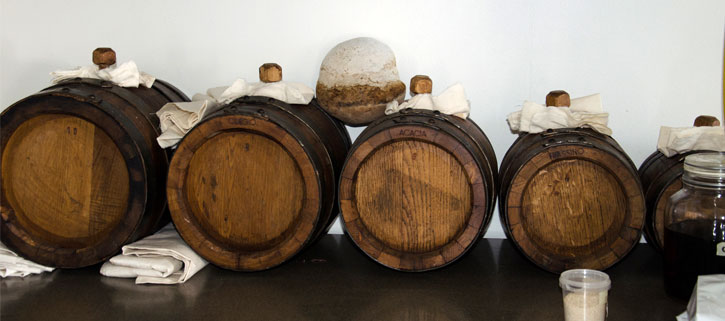
Quince Balsamic Vinegar, the longest project of the Nordic Food Lab. Inside these barrels made with different wood there is Quince Balsamic Vinegar resting. The quince vinegar passes through all barrels as it is transferred from the larger barrel to the next smaller one. This will be ready by 2025.
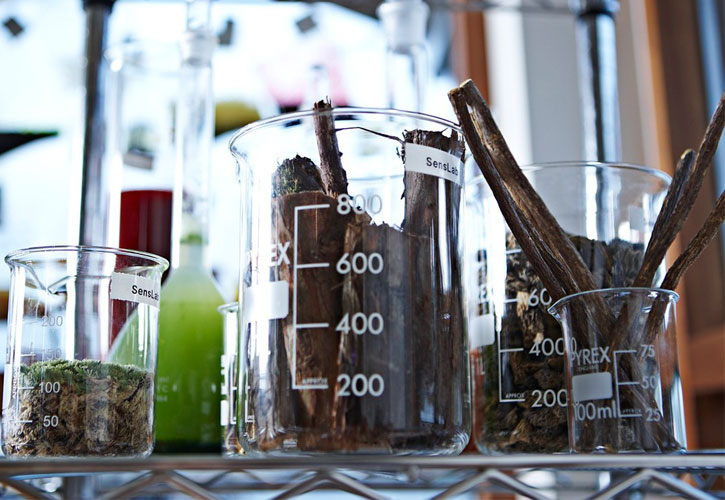
In the glass beakers at Nordic Food Lab we can find a variety of local woods and roots.
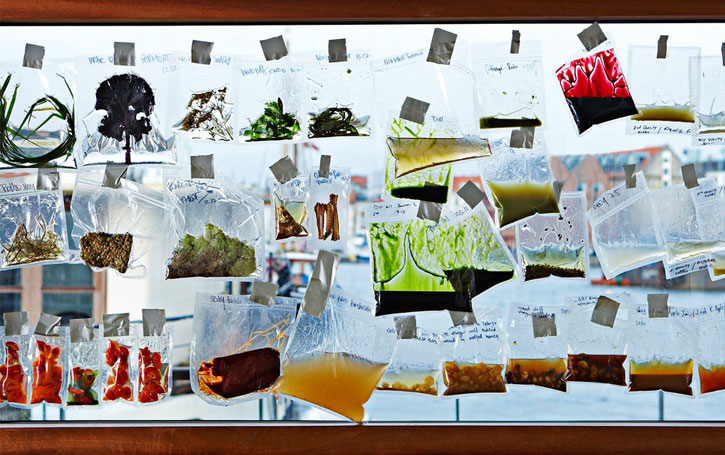
At the window of the Nordic Food Lab we can appreciate a good number of oils, preserved and fermented food.
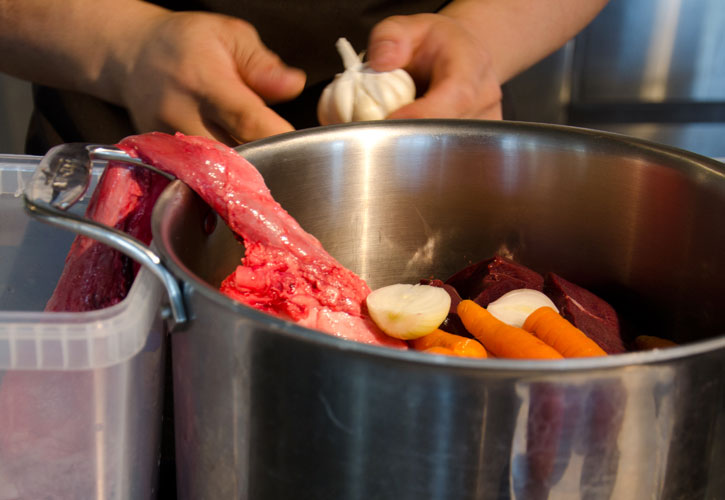
Haggis: The chefs also work on classic preparations. In this case a traditional Scotish Haggis, which was presented at the MAD Symposium.
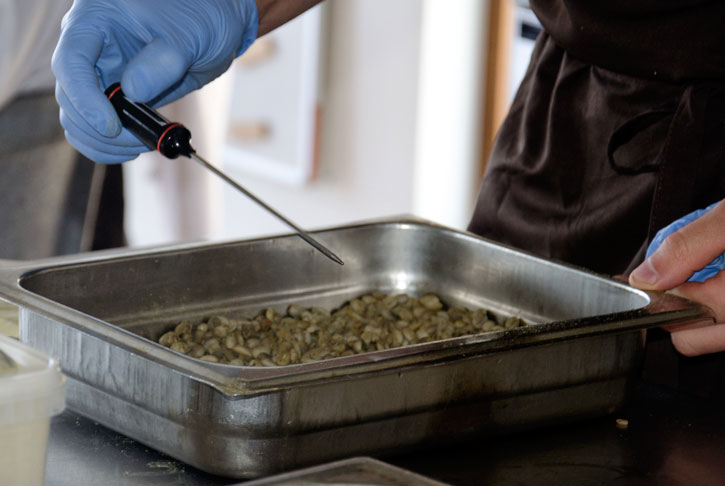
This green coffee bean Koji is a good example of inspiration coming from another country. The traditional Japanese Koji is made with rice or soya bean that has been inoculated with a fermentation culture.
The environment itself is very stimulating. You can see books, white boards with indecipherable formulas written on them, and test tubes with dubious looking liquids and animal organs inside. There are also a few pieces of interesting equipment such as centrifuges and water baths, complete with restaurant kitchen appliances and steel surfaces. But what gives this place its special energy is without a doubt the people who work here.
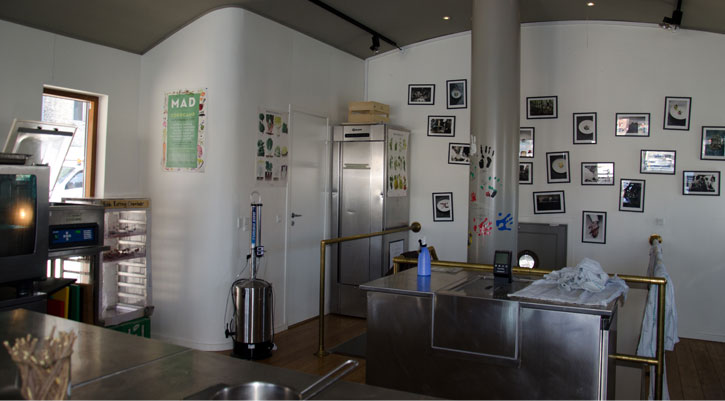
Research Powered by a Multidisciplinary Team
There are only 2 full time employed staff, but there is also a constant flow of people from all over the world who enrich the Food Lab with new information for more interesting discoveries.
“We have some incredible people coming in. All different kind of expertise, from English literature, sustainable agriculture, biotech, biochemistries, sociologists, anthropologist, and of course highly capable cooks. All amazing people who come and share ideas with us. We also work with stagiers; some of them come for a month and they end up staying six. No one wants to leave us, there is a lot of interesting and funny things happening here,” Ben tells us.
On the boat there is activity everywhere. Some people are working with the computer on the outside deck, there is a chef next to us handling a big pot full of lamb's offal and another one smoking pork meat in the back. They are all focused on their work and literally looks like they are searching for something.
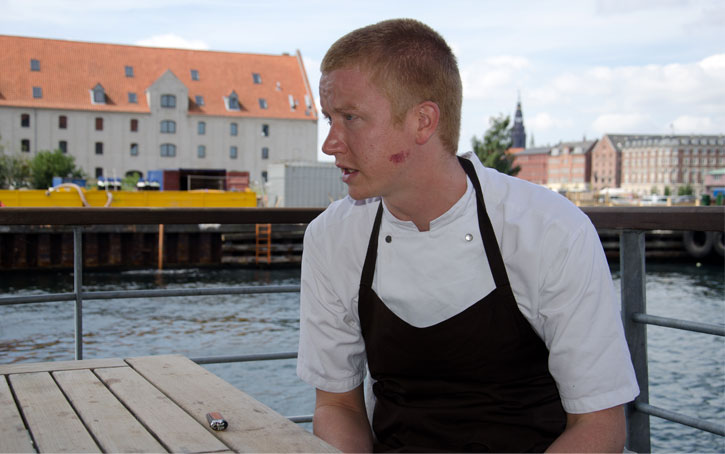
Exploring Edible Biogeography
Ben Reade defines their search as “exploring edible biogeography” – foods that are found locally and define the future of eating sustainably. The pursuit of deliciousness keeps the world robust and is an exploration of the natural world and its resources. They want to explore a local ecology that gives rise to good foods that are available to anyone.
“Many of the times we have not a clue about what will happen with what we are doing, but that is what it’s all about. We just go for it and see what happens,” confesses Ben, and some of the results are just brilliant.
Since its opening, the Nordic Food Lab work has been source of inspiration for many chefs around the world. “We are not focused on making dishes as a final product. What we are doing is building blocks, and is great to see those blocks taken on by other people,” Says Reade.
A good example of this is their recent case studies about fermentation processes and the microbiological research associated with them, now used by many of the top restaurants in Scandinavia. The research about Umami Flavors derived from seaweeds, conducted by Lars Williams –now head of the Test Kitchen at Noma, was another breakthrough in the gastronomic world.
The chefs at the Nordic Food Lab encourage education, autonomy and the search for diverse solutions to the world’s food problems, because nobody has access to the same things, so there is no one “food of the future.” As a matter of fact, Ben is so adamant about that belief that he invites you to give a good punch to anyone that uses the term!
The Art of Eating Bugs: Bee Larvae Ceviche?
One of the ways that Ben and his team are exploring new ways of eating locally involves finding delicious ways to exploit the textures and nutritional value of bugs. Most recently they have been busy experimenting with insects, especially with Ants and Bee Larvae, and in this case they did a great bee larvae Ceviche! The Nordic Food Lab explores how insects have been integrated into local cultures; how they’re used, what their relationship is to the history and culinary possibilities that they possess.
They aren’t trying to replace traditional meats but rather recognize and integrate bugs as an alternate food source that’s local, available, sustainable, and part of the ecology of a place. They’re a good source of nutrition and protein. It’s about exploring the vast world of edible, available ingredients as a supplement to other meats. There are about 1900 different edible varieties of insects; that’s an entire world of possible flavors and deliciousness potential.
Ben believes that getting people to eat bugs (and other non-traditional sources of food) involves two parts: finding ways to make them delicious, and removing the “gross-out” factor in people’s minds. After all, a few decades ago, eating raw fish was a disgusting prospect to most Westerners, but now sushi’s all the rage. It’s because it’s delicious when properly prepared and the mental taboo has been lifted. So it may be with bugs.
This is such a big deal that the Nordic Food Lab has actually received funding to support the research.
Peas, Pizza, Beer and Popcorn Are Still OK!
Don’t be too worried, though. There are many other more delicious sounding items being experimented with, too. For example, they’re exploring ways to use dried yellow peas because peas are a food source that is available to many areas of the world. Soy sauces and vinegars are just some of the results that are in the works.
For those of you who prefer foods that you know AND love, pizza, beer, potatoes, green salads and all of the other good eats are all in the mix, too. After all, the goal is to find sustainable deliciousness that you can find in your own back yard. If you can grow it, the Nordic Food Lab is going to play with it and do their very best to find a way to make it delicious!
Ben and his crew also study themes that go beyond produce and taste, like how colors, sounds and different perceptions affect a meal. Did you know that the simple act of a waiter making physical contact with the customer can lead to at least a 10% increase in the tip, or if you hear the sound of a crispy chip while eating, it can affect how crispy the food feels in your mouth? This is all part and parcel of what the Nordic Food Lab is all about. You can read more about this topic here: Changing Taste with Sounds, Scents, Textures & Colors.
All of this may sound too sophisticated for the majority of us simple cooks and food lovers. The Nordic Food Lab work is ahead of our time, doing the latest research on topics that other people haven’t even considered yet. They’re creating a great database that encompasses a huge amount of information which for sure will be extremely useful for us. We are very happy to be able to share our experience of it with you.
Thanks Ben Reade for receiving us!





